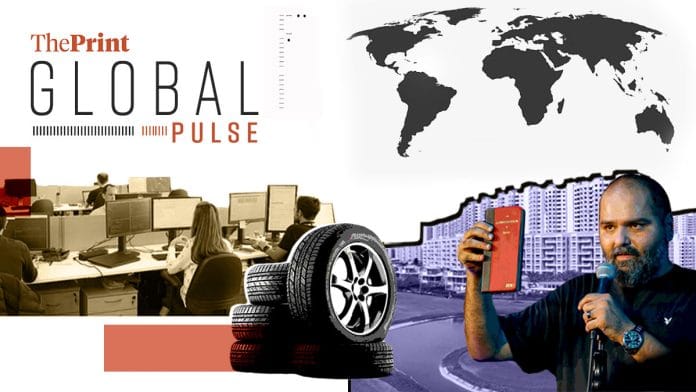New Delhi: US President Donald Trump might be focusing on India’s high tariffs and illegal immigrants, but there’s one aspect of a long partnership that’s going undiscussed—one that “binds together American companies looking for skilled workers overseas and India’s abundant pool of labour,” The New York Times reports.
In a report on India being a hub for global capacity centres, NYT writes that American companies are finding skilled workers in India. “As of 2024, there were about 1,800 offshore corporate offices in India, owned by hundreds of foreign-based multinational companies—most of them American. There are 1.9 million people in India working for foreign companies, with 600,000 to 900,000 more expected to join them by 2030,” it says.
Together, these offshore business centres in India earned about $65 billion last year, more than the value of American imports to India, NYT reports.
“This is welcome news for India, which needs 10 million new jobs each year just to keep unemployment in check. Even with stronger economic growth than any other large country’s, India’s enormous population of young people is in danger of falling behind,” it adds.
This kind of model has been around since the 1990s, leading to the service sector boom, and the familiarity that Americans now have with Indian-accented workers at call centres. The model has changed from offshore subsidiaries providing low-value services to full-fledged branches.
“American companies are assembling their work forces in India, mainly because it has become difficult to find the right kind of workers in the United States,” the report reads. “Studies find that a third of all new engineering jobs go unfilled, while nearly 1.2 million Indians graduate with engineering degrees every year. Lower-wage American workers, who lost jobs as manufacturing work shifted to Asia, have been stranded without retraining.”
It’s the latest wrinkle in a highly globalised world, as the US tries to sever its dependence, the corporate world already exists beyond borders.
The Washington Post reports on a 5,000-acre “experimental community” to the northeast of Mumbai—Palava City. This community, which began construction in 2008 and is being developed in phases by the Lodha Group, is trying to slash its emissions to zero, and also provide a roadmap to other communities.
“As cities around the world grapple with rebuilding after disasters, or meeting the needs of an influx of people, Palava hopes to provide a model for adapting to a climate-transformed world,” the report says.
India is reportedly an ideal place for piloting a net-zero-energy city, aiming to meet all its needs with renewables. But creating and maintaining a “sustainable smart city from scratch is complicated. Palava’s developers have had much more leeway than typical governments, establishing their own management system to handle functions, such as utilities, wastewater treatment and policing”, the report adds.
Building a city in isolation also comes with challenges—it’s been a “decade of experimentation” behind building Palava City, and now life “for the tens of thousands of people living in those modern-looking towers is vastly different than for those living outside”.
“Life in this futuristic development can also come at a greater cost. Apartments in Palava typically start at about 5 million rupees, equivalent to about $58,000, according to Lodha. Last year, the estimated gross national income per capita in India was 208,633 rupees, or just over $2,400,” The Washington Post reports.
The idea is for it to be a blueprint for other developments in India, and by the looks of it, a successful one.
The New York Times also reports on the outrage surrounding comedian Kunal Kamra. “The joke was nothing too unusual for political comedy. But in India, where there is little room anymore to make fun of politicians without drawing court cases or mob violence, all hell quickly broke loose,” it begins.
Pointing out the irony of the Eknath Shinde-led Shiv Sena taking offence to Kamra’s, NYT reminds its readers that the undivided Sena’s founder, Bal Thackeray, was a political cartoonist.
The article describes Kamra as among the “last comedians still taking on politicians in India”, and the comedy club Habitat—which has announced that it’s shutting down—as one of “few places still willing to host shows of an edgy political nature”. It also highlights how Shinde “provided ample comedic material when he left his party in 2022”.
“Comics often turn to joking about how hard it is to joke,” NYT writes.
Meanwhile, the BBC reports that millions of tyres are being sent from the UK to India, not for recycling, but to be “cooked” in makeshift furnaces causing extensive environmental damage and serious health problems.
The report says that it is a well known fact within the industry that a majority of the UK’s exported waste tyres are sold into the Indian black market. “The UK ends up with about 50 million waste tyres (nearly 700,000 tonnes) in need of recycling every year and around half of those are exported to India—according to official figures—where they should end up in recycling plants.”
It adds, “However, some 70 percent of tyres imported by India from the UK and the rest of the world end up in makeshift industrial plants, where they are subjected to what amounts to an extreme form of cooking.” During a process known as pyrolysis, these tyres are essentially pressure cooked and produce dangerous gases and chemicals.
There are up to 2,000 pyrolysis plants in India, where workers are continuously exposed to pollutants that can cause all kinds of illnesses. The Indian government has made it illegal for imported tyres to be used for pyrolysis, yet the practice persists.
(Edited by Mannat Chugh)
Also Read: Why New Delhi seems ‘deluded’ about Trump’s tariffs & India returns to the global rice market






